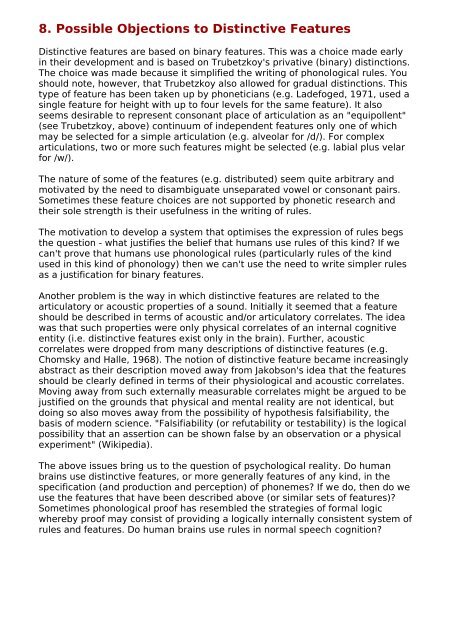Distinctive Features - Speech Resource Pages - Macquarie University
Distinctive Features - Speech Resource Pages - Macquarie University
Distinctive Features - Speech Resource Pages - Macquarie University
Create successful ePaper yourself
Turn your PDF publications into a flip-book with our unique Google optimized e-Paper software.
8. Possible Objections to <strong>Distinctive</strong> <strong>Features</strong><br />
<strong>Distinctive</strong> features are based on binary features. This was a choice made early<br />
in their development and is based on Trubetzkoy's privative (binary) distinctions.<br />
The choice was made because it simplified the writing of phonological rules. You<br />
should note, however, that Trubetzkoy also allowed for gradual distinctions. This<br />
type of feature has been taken up by phoneticians (e.g. Ladefoged, 1971, used a<br />
single feature for height with up to four levels for the same feature). It also<br />
seems desirable to represent consonant place of articulation as an "equipollent"<br />
(see Trubetzkoy, above) continuum of independent features only one of which<br />
may be selected for a simple articulation (e.g. alveolar for /d/). For complex<br />
articulations, two or more such features might be selected (e.g. labial plus velar<br />
for /w/).<br />
The nature of some of the features (e.g. distributed) seem quite arbitrary and<br />
motivated by the need to disambiguate unseparated vowel or consonant pairs.<br />
Sometimes these feature choices are not supported by phonetic research and<br />
their sole strength is their usefulness in the writing of rules.<br />
The motivation to develop a system that optimises the expression of rules begs<br />
the question - what justifies the belief that humans use rules of this kind? If we<br />
can't prove that humans use phonological rules (particularly rules of the kind<br />
used in this kind of phonology) then we can't use the need to write simpler rules<br />
as a justification for binary features.<br />
Another problem is the way in which distinctive features are related to the<br />
articulatory or acoustic properties of a sound. Initially it seemed that a feature<br />
should be described in terms of acoustic and/or articulatory correlates. The idea<br />
was that such properties were only physical correlates of an internal cognitive<br />
entity (i.e. distinctive features exist only in the brain). Further, acoustic<br />
correlates were dropped from many descriptions of distinctive features (e.g.<br />
Chomsky and Halle, 1968). The notion of distinctive feature became increasingly<br />
abstract as their description moved away from Jakobson's idea that the features<br />
should be clearly defined in terms of their physiological and acoustic correlates.<br />
Moving away from such externally measurable correlates might be argued to be<br />
justified on the grounds that physical and mental reality are not identical, but<br />
doing so also moves away from the possibility of hypothesis falsifiability, the<br />
basis of modern science. "Falsifiability (or refutability or testability) is the logical<br />
possibility that an assertion can be shown false by an observation or a physical<br />
experiment" (Wikipedia).<br />
The above issues bring us to the question of psychological reality. Do human<br />
brains use distinctive features, or more generally features of any kind, in the<br />
specification (and production and perception) of phonemes? If we do, then do we<br />
use the features that have been described above (or similar sets of features)?<br />
Sometimes phonological proof has resembled the strategies of formal logic<br />
whereby proof may consist of providing a logically internally consistent system of<br />
rules and features. Do human brains use rules in normal speech cognition?
















